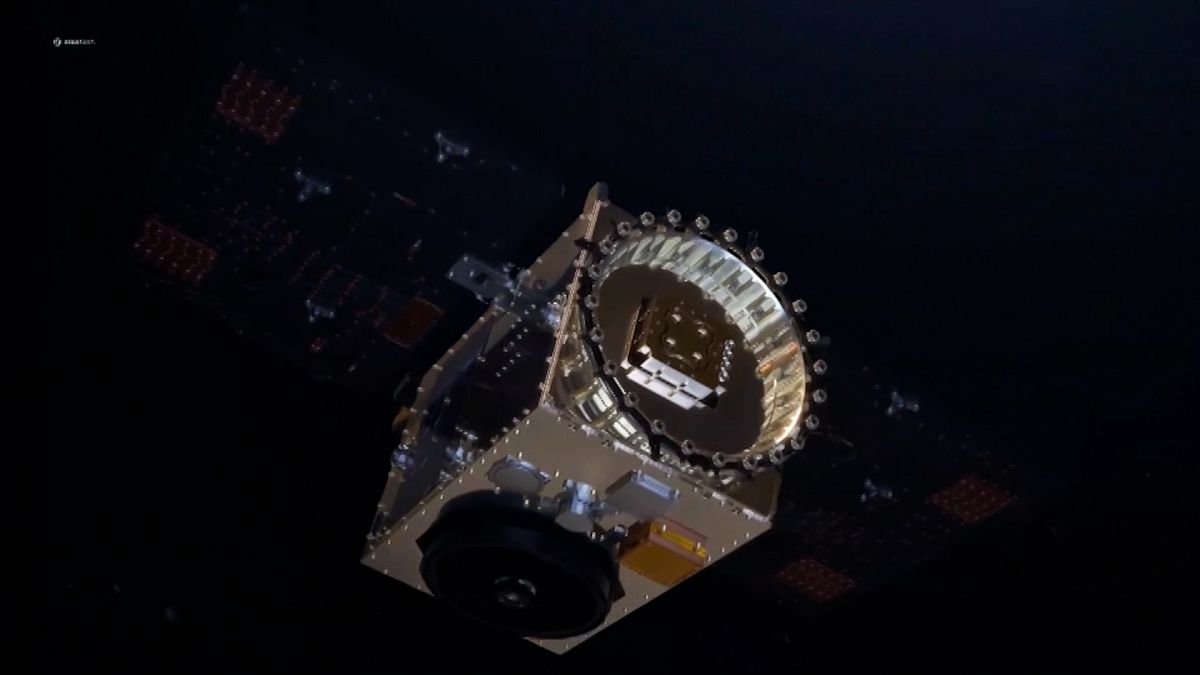August 19, 2024
XINHUA – As China forges ahead with its high-quality development, new quality productive forces are taking the centre stage.
One of the key players, the commercial space sector, is experiencing rapid growth and making a mark on the global stage.
In December 2023, Beijing Interstellar Glory Space Technology, better known as iSPACE, conducted another successful test of its own reusable launcher, marking a step toward a fully functional, domestically manufactured reusable rocket for China’s commercial spaceflight industry.
This private Chinese aerospace company is looking to catch up with the world’s most advanced rocket technologies.
“There is still a long way ahead. But we’re catching up fast,” vice manager of iSPACE Anna Choi told Xinhua.
In 2019, the Chinese startup successfully launched its SQX-1 Y1 rocket, sending two satellites into a 300-km circular orbit. It was the first time a private Chinese company managed to put a satellite into orbit. Its test on December 10 last year verified the Hyperbola-2Y as a reusable liquid oxygen and methane carrier rocket – the first of its kind in the country. It is part of an iSPACE plan to launch a reusable medium-lift rocket into orbit in late 2025.
Since its inception in 2016, the company’s staff has expanded from less than 10 to more than 400 people.
Choi said both the company and the industry are growing at a fast pace, propelled by technological innovation and catalysed by the government’s supportive policies.
iSPACE is one of several Chinese enterprises active in the commercial aerospace industry in recent years. The country has experienced an explosion of commercial space companies since 2014, driven by the government’s opening up of the sector to private capital.
According to media reports, in 2023 alone, the country’s private commercial spaceflight companies managed more than 10 successful launches.
Like iSPACE, most of these enterprises are headquartered in Beijing, attracted by the capital’s rich talent pool and supportive policies.
Beijing in February 2024 announced plans to establish a dedicated ‘Rocket Street’ as a research and production hub for advancement of the commercial aerospace sector.
Construction started last month at the Beijing Economic-Technological Development Area (BDA), located in a southeastern suburb of Beijing.
“Through the ‘Rocket Street’ programme, we hope to leverage the cluster advantage to facilitate the development of the sector,” said a BDA official. The capital city’s endeavour to foster the commercial aerospace sector comes amid the country’s efforts to develop new quality productive forces to help advance the world’s second-largest economy up the global value chain.
Developing commercial spaceflight was listed among the key areas for development in China’s government work report this year. These priorities, which also include bio-manufacturing, the low-attitude economy, quantum technology and life sciences, form part of the country’s agenda to pursue sustainable growth through developing strategically important and future-oriented industries.
Reflecting the rising level of government support, Choi said the municipal government provided subsidies for the commercial aerospace industry to set up innovation centres focusing on developing reusable rockets.
The government is also striving to encourage more private capital investment in this sector.
Historic milestone for Polish Space science as they successfully launch Eagleeye satellite

Poland's space industry marks historical day.
Polish space science and technology reached a historical moment with the successful launch of the EagleEye satellite into Earth's orbit. Facilitated by SpaceX, the mission took place from Vandenberg Space Force Base in California.
The EagleEye project, which began in April 2020, represents a collaborative effort between a consortium of industrial and scientific organisations.
Creotech Instruments S.A. leads the consortium, with contributions from Scanway Sp. z o.o. and the Space Research Center of the Polish Academy of Sciences, which serves as the scientific partner.
The satellite is set to deliver high-resolution images of the Earth, providing data for research and monitoring purposes.
The mission is expected to last at least one year, whist its control center for EagleEye is situated at Creotech Instruments' headquarters in Warsaw. The satellite is to orbit the Earth at a low altitude, gradually descending from an initial height of approximately 500 kilometers to around 350 kilometers.
Barciński emphasised that this success was not guaranteed and marked an important milestone in the mission's progress.
EagleEye was designed entirely in Poland from the ground up. While acknowledging that not all components could be made locally, for example Poland does not yet manufacture microprocessors, Dr. Barciński stressed that the satellite is equipped with high range technology.
Copyright © africanewsJohn Raoux/Copyright 2024
By Rédaction Africanews
Senegal has marked an historic milestone with the successful launch of its first satellite from California on Friday evening.
It has become one of just 12 African nations with their own surveillance and telecommunications satellites in space.
The country’s President Bassirou Diomaye Faye said the move marks a major step towards Senegal’s “technological sovereignty”.
"I would like to express my pride and gratitude to all those who made this project possible," he said in a post on X.
Maram Kaïré, director of Senegal's space agency, described the launch as “an important step and a historic day in our country's progress and determination to become a space-faring nation”.
GAINDESAT-1A was built by Senegalese engineers in collaboration with France’s Montpellier University Space Centre.
The nanosatellite was launched into orbit, together with 115 others, from the Vandenberg base in California using SpaceX's Falcon 9 rocket.
It will be used to collect data for various state agencies including those dealing with water resources, civil aviation, and meteorology.
Right on schedule: Physicists use modeling to forecast a black hole's feeding patterns with precision
The dramatic dimming of a light source ~ 860 million light-years away from Earth confirms the accuracy of a detailed model developed by a team of astrophysicists from Syracuse University, MIT and the Space Telescope Science Institute.
Syracuse University
image:
Digital illustration of a star shedding stellar debris as it orbits a supermassive black hole. This artist’s impression represents the center of a galaxy about 860 million light-years from Earth.
view moreCredit: NASA/CXC/M.Weiss
Powerful telescopes like NASA’s Hubble, James Webb, and Chandra X-ray Observatory provide scientists a window into deep space to probe the physics of black holes. While one might wonder how you can “see” a black hole, which famously absorbs all light, this is made possible by tidal disruption events (TDEs) - where a star is destroyed by a supermassive black hole and can fuel a “luminous accretion flare.” With luminosities thousands of billions of times brighter than the Sun, accretion events enable astrophysicists to study supermassive black holes (SMBHs) at cosmological distances.
TDEs occur when a star is violently ripped apart by a black hole’s immense gravitational field. As the star is shredded, its remnants are transformed into a stream of debris that rains back down onto the black hole to form a very hot, very bright disk of material swirling around the black hole, called an accretion disc. Scientists can study these to make direct observations of TDEs, and compare those to theoretical models to relate observations to physical properties of disrupted stars and their disrupting black holes.
A team of physicists from Syracuse University, MIT and the Space Telescope Science Institute used detailed modeling to predict the brightening and dimming of AT2018fyk, which is a repeating partial TDE, meaning the high-density core of the star survived the gravitational interaction with the SMBH, allowing it to orbit the black hole and be shredded more than once. The model predicted that AT2018fyk would “dim” in August 2023, a forecast which was confirmed when the source went dark last summer, providing evidence that their model delivers a new way to probe the physics of black holes. Their results were published in The Astrophysical Journal Letters.
A High Energy Source
Thanks to incredibly detailed extragalactic surveys, scientists are monitoring more coming and going light sources than ever before. Surveys pan entire hemispheres in search of sudden brightening or dimming of sources, which tells researchers that something has changed. Unlike the telescope in your living room that can only focus visible light, telescopes such as Chandra can detect light sources in what’s referred to as the X-ray spectrum emitted from material that is millions of degrees in temperature.
Visible light and X-rays are both forms of electromagnetic radiation, but X-rays have shorter wavelengths and more energy. Similar to the way in which your stove becomes “red hot” after you turn it on, the gas comprising a disc “glows” at different temperatures, with the hottest material closest to the black hole. However, instead of radiating its energy at optical wavelengths visible to the eye, the hottest gas in an accretion disc emits in the X-ray spectrum. These are the same X-rays used by doctors to image your bones and that can pass through soft tissue, and because of this relative transparency, the detectors used by NASA X-ray telescopes are specifically designed to detect this high-energy radiation.'
A Repeat Performance
In January 2023, a team of physicists, including Eric Coughlin, a professor at Syracuse University’s Department of Physics, Dheeraj R. “DJ” Pasham, a research scientist at MIT, and Thomas Wevers, a Fellow at the Space Telescope Science Institute, published a paper in The Astrophysical Journal Letters that proposed a detailed model for a repeating partial TDE. Their results were the first to map a star’s surprising return orbit about a supermassive black hole – revealing new information about one of the cosmos’ most extreme environments.
The team based their study on a TDE known as AT2018fyk (AT stands for “Astrophysical Transient”), where a star was proposed to be captured by a SMBH through an exchange process known as “Hills capture.” Originally part of a binary system (two stars that orbit one another under their mutual gravitational attraction), one of the stars was hypothesized to have been captured by the gravitational field of the black hole and the other (non-captured) star was ejected from the center of the galaxy at speeds comparable to ~ 1000 km/s.
Once bound to the SMBH, the star powering the emission from AT2018fyk has been repeatedly stripped of its outer envelope each time it passes through its point of closest approach with the black hole. The stripped outer layers of the star form the bright accretion disk, which researchers can study using X-Ray and Ultraviolet /Optical telescopes that observe light from distant galaxies.
While TDEs are usually “once-and-done” because the extreme gravitational field of the SMBH destroys the star, meaning that the SMBH fades back into darkness following the accretion flare, AT2018fyk offered the unique opportunity to probe a repeating partial TDE.
The research team has used a trio of telescopes to make the initial and follow-up detections: Swift and Chandra, both operated by NASA, and XMM-Newton, which is a European mission. First observed in 2018, AT2018fyk is ~ 870 million light years away, meaning that because of the time it takes light to travel, it happened in “real time” ~ 870 million years ago.
The team used detailed modeling to forecast that the light source would abruptly disappear around August 2023 and brighten again when the freshly stripped material accretes onto the black hole in 2025.
Model Validation
Confirming the accuracy of their model, the team reported an X-ray drop in flux over a span of two months, starting on August 14, 2023. This sudden change can be interpreted as the second emission shutoff.
“The observed emission shutoff shows that our model and assumptions are viable, and suggests that we are really seeing a star being slowly devoured by a distant and very massive black hole,” says Coughlin. “In our paper last year, we used constraints from the initial outburst, dimming and rebrightening to predict that AT2018fyk should display a sudden and rapid dimming in August of 2023, if the star survived the second encounter that fueled the second brightening.”
The fact that the system displayed this predicted shutoff therefore implies several distinctions about the star and the black hole:
- the star survived its second encounter with the black hole;
- the rate of return of stripped debris to the black hole is tightly coupled to the brightness of AT2018fyk;
- and the orbital period of the star about the black hole is ~ 1300 days, or about 3.5 years.
The second cutoff implies that another rebrightening should happen between May and August of 2025, and if the star survived the second encounter, a third shutoff is predicted to occur between January and July of 2027.
As for whether we can count on seeing a rebrightening in 2025, Coughlin says the detection of a second cutoff implies that the star has had more mass freshly stripped, which should return to the black hole to produce a third brightening.
“The only uncertainty is in the peak of the emission,” he says. “The second re-brightened peak was considerably dimmer than the first, and it is, unfortunately, possible that the third outburst will be dimmer still. This is the only thing that would limit the detectability of this third outburst.”
Coughlin notes that this model signifies an exciting new way to study the incredibly rare occurrences of repeating partial TDEs, which are believed to take place once every million years in a given galaxy. To date, he says scientists have encountered only four to five systems that display this behavior.
“With the advent of improved detection technology uncovering more repeating partial TDEs, we anticipate that this model will be an essential tool for scientists in identifying these discoveries,” he says.
X-ray and optical image of AT2018fyk (IMAGE)
X-ray and optical image of AT2018fyk.
Credit
X-ray: NASA/SAO/Kavli Inst. at MIT/D.R. Pasham; Optical: NSF/Legacy Survey/SDSS
Journal
The Astrophysical Journal Letters
Method of Research
Computational simulation/modeling
Subject of Research
Not applicable
Article Title
A Potential Second Shutoff from AT2018fyk: An Updated Orbital Ephemeris of the Surviving Star under the Repeating Partial Tidal Disruption Event Paradigm
Article Publication Date
14-Aug-2024
Backyard stargazers find object moving 1 million mph

The Event Horizon Project on May 12, 2022, released the first image of at the Milky Way black hole Sagittarius A*.
Aug. 15 (UPI) -- Backyard stargazers have discovered an object moving at more than a million mph through space, an interstellar phenomenon that typically takes the resources of high-tech observatories, the smartest scientists and high-dollar research to see, NASA announced Thursday.
Interstellar enthusiasts working on NASA's Backyard Worlds: Planet 9 project helped discover an object moving so quickly that it will defy the Milky Way's gravity and jettison into intergalactic space.
"This hypervelocity object is the first such object found with the mass similar to or less than that of a small star," NASA said in a release about the discovery.
"I can't describe the level of excitement," said Kabatnik, a citizen scientist from Nuremberg, Germany. "When I first saw how fast it was moving, I was convinced it must have been reported already."
Kabatnik was part of the Backyard Worlds team, which uses images from NASA's WISE, or Wide Field Infrared Explorer, mission, which mapped the sky in infrared light from 2009 to 2011.
It was in analyzing this data that Kabatnik and other enthusiasts, Thomas P. Bickle, and Dan Caselden, located the object, known cryptically as CWISE J124909.08+362116.0, streaking faintly across the sky.
CWISE also stands out for its low mass, NASA said, making it difficult to classify as a celestial body and may best be described as a brown dwarf. Backyard Worlds teams have discovered as many as 4,000 of those, but none traveling so fast that it will slip the bonds of gravity and shoot into intergalactic space.
There are a few hypotheses as to why CWISE J1249 is traveling so fast. One is that it is the remnant of a white dwarf that exploded, and another is that it came from a group of stars called a globular cluster, and a chance meeting with a pair of black holes sent it soaring away.
"When a star encounters a black hole binary, the complex dynamics of this three-body interaction can toss that star right out of the globular cluster," Kyle Kremer, incoming assistant professor in UC San Diego's Department of Astronomy and Astrophysics said in the NASA release.
NASA and astronomers continue to seek backyard stargazers all over the world who want to volunteer to help in efforts to discover similar wonders in the future.
Scientists have also relied on backyard researchers to help battle the effects of climate change.























